Overview of the Global Anemia Problem, Including Iron Deficiency Anemia
The World Health Organization (WHO) defines anemia among women of childbearing age as the condition of having a hemoglobin concentration of < 12.0 g/dL at sea level; among pregnant women it is defined as < 11.0 g/dL. The hemoglobin concentration cutoff level that defines anemia varies by age, gender, physiological status, smoking status, and the altitude at which the assessed population lives.
The primary cause of anemia is iron deficiency, a condition caused by inadequate intake or low absorption of iron, the increased demands of repeated pregnancies—particularly if not well spaced (e.g., fewer than 36 months between pregnancies)—and loss of iron through menstruation. Other causes of anemia include vitamin deficiencies (such as a deficiency of folic acid or vitamin A), genetic disorders, malaria, parasitic infections, HIV, tuberculosis, common infections, and other inflammatory conditions. While iron deficiency anemia (IDA) accounts for about one-half of all anemia cases, it often coexists with these other causes.
Iron deficiency anemia is most common during pregnancy and in infancy, when physiological iron requirements are the highest and the amount of iron absorbed from the diet is not sufficient to meet many individuals’ requirements (Stoltzfus and Dreyfuss 1998). Anemia’s effects include increased risk of premature delivery, increased risk of maternal and child mortality, negative impacts on the cognitive and physical development of children, and reduced physical stamina and productivity of people of all ages (Horton and Ross 2003). Globally, IDA annually contributes to over 100,000 (22 percent of all maternal deaths) and over 600,000 perinatal deaths (Stoltzfus, Mullany, and Black 2004). Key anemia control interventions include promoting a diversified diet, iron-folic acid (IFA) supplementation during pregnancy, iron fortification of staple foods, prevention and treatment of malaria, use of insecticide-treated bed nets, helminth prevention and control, delayed cord clamping, and increased birth spacing.
Maternal Anemia in Benin
The prevalence of anemia among pregnant women in Benin is 75 percent, making it a severe public health problem as defined by WHO standards1 (INSAE and Macro International 2007). In terms of anemia severity, the majority of cases among pregnant and breastfeeding or non-pregnant women of reproductive age reported in the 2006 Benin Demographic and Health Survey (BDHS) are classified as mild or moderate.2 Only 2.2 percent of anemia cases in pregnant women and less than one percent of those in breastfeeding or non-pregnant women are diagnosed as severe. The high prevalence of anemia among pregnant women persists in the presence of anemia interventions. In a study that measured the prevalence of anemia during various stages of pregnancy in a southern Benin town, pregnant women received two intermittent preventive treatments (IPTs) for malaria and had low-cost access to insecticide-treated bed nets, treatment for helminths, and iron and folic acid supplements. Nevertheless, the prevalence of anemia among pregnant women remained high during the second (65 percent) and third trimesters (64 percent) as well as at the time of delivery (40 percent) (Bodeau-Livinec et al. 2011).
Falter Points in Women's Consumption of Iron-Folic Acid During Pregnancy
WHO recommends that all pregnant women receive a standard dose of 30–60 mg iron and 400 μg folic acid beginning as soon as possible during gestation (WHO 2012). Ideally, women should receive iron-containing supplements no later than the first trimester of pregnancy, which means ideally taking 180 tablets before delivery. It is important to note, that many countries aim for women to receive 90 or more tablets during pregnancy.
Figure 1. Analysis of Falter Points Related to Distribution and Consumption of IFA through Benin’s ANC Program in 2006, Covering Women of Reproductive Age (15–49 Years) n = 17,794
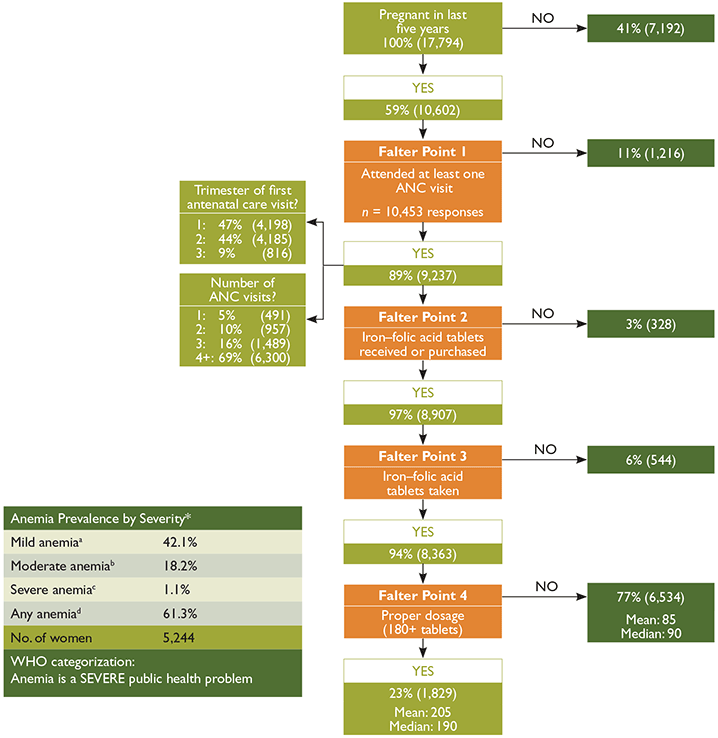
Main Conclusions: ANC coverage in Benin is high, providing a strong platform for distibuting IFA. Among women who were pregnant in the last five years, had at least one ANC visit, and took at least one IFA tablet, only 23 percent received and took the ideal minimum number of tablets. Falter Points 1 and 4 are the most critical shortcomings within the system, indicating likely supply and demand side constraints.
*Percentage of women 15–49 years based on Hemoglobin levels, Hb (g/dL)
aNPW 10.0≤Hb≤11.9, PW 10.0≤Hb≤10.9 b NPW 7.0≤Hb<9.9, PW 7.0≤Hb<9.9 cNPW Hb<7.0, PW Hb<7.0 dNPW Hb<12.0, PW Hb<11.0
Non-responses, no data (NR/ND) were recoded to “No” for “”At least 1 ANC visit?” “IFA tablets received?” and “IFA tablets taken?” and to zero for “Number of tablets taken?”.
Anemia prevalence data are provided as a reference point, signaling the general order of magnitude of the anemia public health problem. The ANC utilization data is based on self-reported data of women 15–49 years in permanent unions and pertains to their last pregnancy in the last five years prior to the DHS.
Source: Calculations and anemia levels are from the Benin Demographic and Health Survey (2006).
Figure 1 shows a decision-tree analysis of how well the Beninese antenatal care (ANC) system distributes IFA, and identifies four potential points at which the system might falter (highlighted in orange). The figure tracks the number and percentage of women who obtained ANC, those who subsequently received and consumed at least one IFA tablet, and those who consumed the ideal minimum number of tablets.3 All data are based on BDHS questions asked of women who were in permanent unions and had been pregnant in the five years prior to being interviewed4 (INSAE and Macro International 2007).
Many supply-side aspects—including both adequacy of IFA tablet supplies and technical knowledge and practices of ANC providers—need to be considered when assessing how well an ANC program delivers IFA. In addition, as Falter Point 4 in Figure 1 clearly shows, the provision of IFA tablets to a pregnant woman is a necessary but not sufficient condition for the woman to consume the tablets, particularly at the ideal minimum level. Thus, demand-side factors also play a critical role in determining the coverage and effectiveness of a program. These include whether or not women seek ANC and the timing and number of visits, as well as the extent to which women are aware of the significance of anemia and IFA, ask for IFA tablets, and comply with the IFA regimen.
Understanding the relative significance of each falter point makes it possible to prioritize them for more in-depth analysis, providing a first step in an evidence-based approach to systematically improving the program. The BDHS does not collect information on the number of IFA tablets received by women. In the case of Falter Point 4, this lack of data creates ambiguities that make it impossible to fully understand whether shortcomings in the system relate primarily to supply- or demand-side factors. Despite this limitation, the decision-tree analysis presented in Figure 1 still enables prioritizing the falter points for more in-depth analysis and action at the national, district, and health center levels.
Analysis of Falter Points
Falter Point 1:
Did not attend at least one ANC visit
Only 11 percent of women did not have at least one ANC visit.
ANC’s relatively high coverage gives it strong potential as a vehicle for providing IFA.
Falter Point 2:
Did not receive or purchase at least one IFA tablet
Of the women who had at least one ANC visit, three percent did not receive or purchase any IFA.
This supply-side constraint is relatively small and may be due to various system/supply-side performance shortcomings, which could reflect: (1) inadequate supply (e.g., stockouts); (2) inadequate provider knowledge; or (3) inadequate provider practices, whereby IFA may not have been provided.
Unfortunately, the BDHS does not report the source(s) of the IFA tablets women received or purchased, and a small percentage of women attending ANC get IFA tablets from a different source. While only two percent of Beninese women who received or purchased IFA did not have any ANC visits (not shown), we cannot ascertain whether or not those who received ANC obtained their IFA from their ANC provider. However, women who attend ANC may be more likely to be aware of, to value, and also to take IFA tablets, regardless of where they obtain them. Thus, we would expect a high correlation between the number of women who had at least one ANC visit and those who received or purchased IFA, which is consistent with the data. Women who had one or more ANC visits and who did not receive any IFA represent a missed opportunity to reduce the risk of anemia among a high-risk population.
Falter Point 3:
Did not take at least one IFA tablet
Of the women who received IFA, six percent did not take any tablets.
This demand-side constraint is relatively small and may be due to women not understanding the significance of anemia and/or the significance of IFA. This misunderstanding may reflect: (1) inadequate provider counseling and follow-up; (2) women’s beliefs about actual or possible side effects; or (3) sociocultural factors.
Falter Point 4:
Did not consume 180 or more IFA tablets
Of the women who received and took IFA, 77 percent did not consume the ideal minimum of 180 tablets.
This constraint results from a combination of supply- and/or demand-side factors. Figure 1 suggests two possible causes of this falter point: 53 percent of women who received ANC began their care after the first trimester, and the 31 percent who had fewer than WHO’s recommended four ANC visits during their last pregnancy may have started their ANC too late or may not have had enough visits to receive 180 tablets (given IFA distribution protocols). Both of these are likely contributing factors, but further research is needed to establish their relative importance, as well as the significance of other possible causes.
Globally, research has found that other common causes of Falter Point 4 include: (1) providers do not have access to adequate supply; (2) women do not receive an adequate number of tablets because they have little access to care, start ANC late, or do not have enough ANC visits, making it difficult to obtain 180 tablets (given IFA distribution protocols); (3) providers do not provide adequate counseling or follow-up; (4) women do not adhere to the regimen, which may be due to difficulty in remembering to take the tablets daily, not knowing all the tablets are necessary, fear of having a big baby, side effects, or tablet-related issues (taste, size, color, coating, packaging/storage problem). Further research is needed to determine the specific reasons for this falter point in Benin.
Analysis by Sociodemographic Variables and Trends Over Time
A comparison of data from the 2001 and 2006 BDHS (Figure 2) highlights Benin’s progress in improving IFA coverage and increasing the number of IFA tablets taken over the five-year period. IFA coverage (defined as the percentage of women, among all women who were pregnant in the past five years, who received and took at least one IFA tablet) rose by a modest two percent while the percentage of pregnant women taking 90-plus tablets rose by 33 percent. While IFA trends are encouraging, ANC coverage has dropped slightly. Eighty-eight percent of women were receiving ANC during their pregnancy in 2006, a decrease of two percentage points from 2001. Additionally, the percentage of women who had four or more ANC visits, as recommended by WHO, dropped by one percentage point to 61 percent.
Table 1 goes into further depth on two key ANC indicators in Benin: the number of ANC visits and the timing of the first visit. Although more women are not receiving ANC and fewer women are obtaining four-plus ANC visits, the timing of ANC has improved. Thirteen percent more women obtain their first ANC visit within the first trimester of pregnancy and fewer women are receiving their first visit past the fourth month of pregnancy since 2001. Continued improvement in the percentage of women receiving ANC early in pregnancy coupled with improved ANC counseling on the health benefits of taking IFA have the potential to increase the number of women taking the ideal minimum of 180 IFA tablets (addressing Falter Point 4) and thereby to reduce the nationwide prevalence of anemia.
Table 2 provides a disaggregated look at IFA and ANC coverage throughout Benin and reveals large discrepancies in coverage across the geographic departments. Both the lowest IFA and ANC coverage occur in Alibori, located in north Benin, at 62 and 63 percent, respectively. The departments of Borgou and Atacora also have notably low coverage rates for both ANC and IFA. At the upper end, Littoral has nearly universal ANC coverage and the highest IFA coverage of all departments, at 98 percent. Variations in coverage by residence area are less marked, although rural pregnant women are less likely to receive ANC and IFA than their urban counterparts and women living in the most populous city (Cotonou). A considerable gap in coverage exists between women in the lowest and highest wealth quintiles: a difference of 18 percent in ANC coverage and 21 percent in IFA coverage.
Figure 2. Progress in ANC and IFA Indicators in Benin, 2001–2006
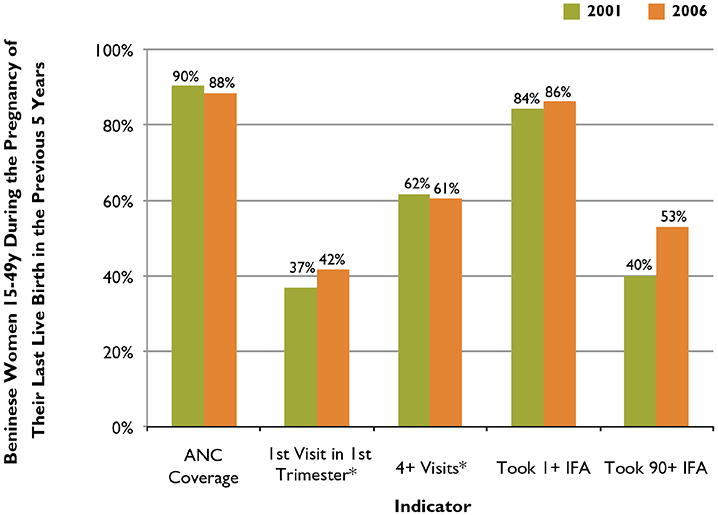
Table 1. Number and Timing of ANC Visits in Benin, 2001 and 2006
| Indicator | 2001 | 2006 | Change in Coverage | Percentage Change |
|---|---|---|---|---|
| Number of ANC Visits | ||||
| Month of First Visit | ||||
| 0 | 9.4% | 11.2% | 1.8% | 19.1% |
| 1 | 4.7% | 4.5% | –0.2% | –4.3% |
| 2-3 | 22.0% | 22.4% | 0.4% | 1.8% |
| 4+ | 61.6% | 60.5% | –1.1% | –1.8% |
| Don't Know/No Data | 2.2% | 1.4% | –0.8% | –36.4% |
| No ANC | 9.4% | 11.2% | 1.8% | 19.1% |
| < 4 | 36.8% | 41.7% | 4.9% | 13.3% |
| 4-5 | 33.4% | 30.2% | –3.2% | –9.6% |
| 6-7 | 16.9% | 13.8% | –3.1% | –18.3% |
| 8+ | 2.7% | 2.3% | –0.4% | –14.8% |
| Don't Know/No Data | 0.9% | 0.7% | –0.2% | –22.2% |
Table 2. ANC and IFA Coverage During Last Pregnancy in the Last Five Years by Department, Residence Area, and Wealth, Benin, 2006
| Characteristic | No. Women with a Live Birth-Last 5 Years | Received ANC | Took 1+ IFA Tablet | ||
|---|---|---|---|---|---|
| Number | Percentage | Number | Percentage | ||
| Department | |||||
| Residence Area | |||||
| Wealth | |||||
| Alibori | 935 | 584 | 62.5% | 580 | 62.0% |
| Atacora | 751 | 570 | 75.9% | 533 | 71.0% |
| Atlantique | 1,166 | 1,154 | 99.0% | 1,124 | 96.4% |
| Borgou | 1,033 | 709 | 68.6% | 699 | 67.7% |
| Collines | 761 | 723 | 95.0% | 708 | 93.1% |
| Couffo | 863 | 767 | 88.9% | 773 | 89.6% |
| Donga | 439 | 361 | 82.2% | 354 | 80.6% |
| Littoral | 771 | 767 | 95.5% | 759 | 98.4% |
| Mono | 636 | 607 | 95.4% | 561 | 82.2% |
| Ouémé | 1,438 | 1,407 | 97.8% | 1,382 | 96.1% |
| Plateau | 543 | 482 | 88.8% | 470 | 86.6% |
| Zou | 1,185 | 1,155 | 97.5% | 1,119 | 94.4% |
| Cotonou | 771 | 767 | 99.5% | 759 | 98.4% |
| Other cities | 2,972 | 2,708 | 91.1% | 2,672 | 89.9% |
| Urban complex | 3,742 | 3,474 | 92.8% | 3,428 | 91.6% |
| Rural | 6,779 | 5,812 | 85.7% | 5,633 | 83.1% |
| Lowest 40% | 4,296 | 3,394 | 79.0% | 3,265 | 76.0% |
| Highest 40% | 4,052 | 3,941 | 97.3% | 3,910 | 96.5% |
| National Average | 10,521 | 9,286 | 88.3% | 9,059 | 86.1% |
Analysts by Geographic Region
The map in Figure 3 shows the variation by department in the percentage of women who attended at least one ANC visit and received at least one IFA tablet. IFA coverage among those attending ANC is very high and little variation exists between departments. Coverage ranges from 92 to 99 percent, which is impressively high compared to other low- and middle-income countries. Given the high IFA coverage among women who received ANC, the map presents a potential missed opportunity in getting more women to achieve an ideal minimum 180-tablet regimen during their pregnancy (by addressing Falter Points 3 and 4 among women receiving IFA through ANC) and reemphasizes that expanding ANC may help improve access to IFA.
Figure 3. Percentage of Women Who Had at Least One ANC Visit and Received at Least One IFA Tablet by Department, Benin, 2006
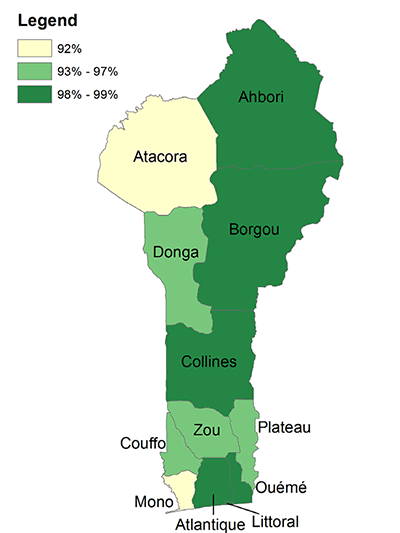
Analysis by Number of ANC Visits
Figure 4 shows the relationship between the number of IFA tablets taken by women who had at least one ANC visit, and the number of ANC visits they had during their last pregnancy. Twenty-seven percent of women who had at least one ANC visit took, at most, one-quarter (45) of the ideal minimum number of IFA tablets. Additional ANC visits usually, but not always, result in a modest increase in the number of IFA tablets taken. Only 28 percent of women with four or more ANC visits took at least 180 IFA tablets; however, this is more than double the percentage of women with less than four ANC visits who took at least 180 tablets. Learning what accounts for the apparent ceiling in the number of IFA tablets distributed and taken is a critical challenge for improving the effectiveness of ANC-based distribution of IFA in Benin.
Figure 4. ANC Distribution of IFA Tablets: Number of Tablets Received and Taken According to Number of ANC Visits, Benin, 2006
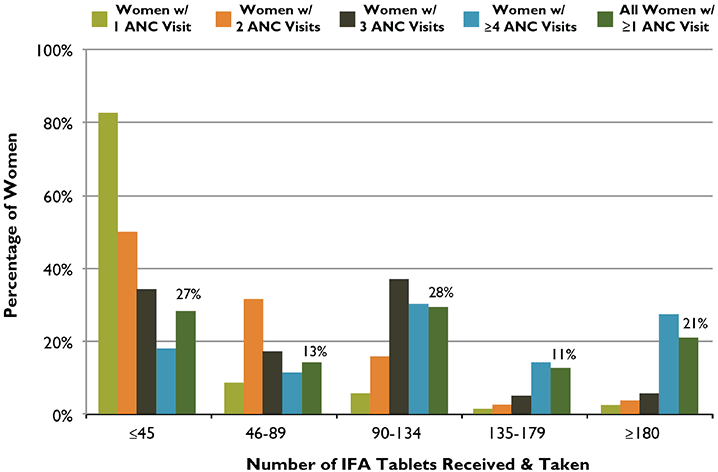
Figure 5. Relative Importance of Each Falter Point in Benin: Why Women Who Were Pregnant in the Last Five Years Failed to Take the Ideal Minimum of 180 IFA Tablets
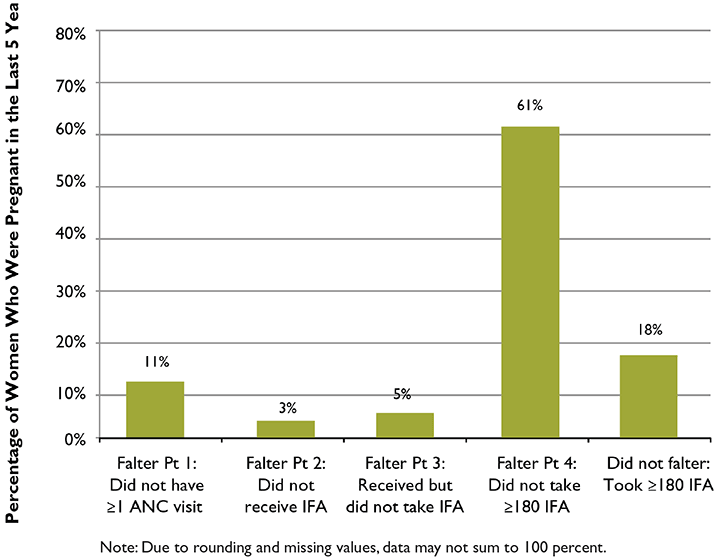
Overall Conclusions and Recommendations
Figure 5 presents the obstacles among all pregnant women—including those who did not receive ANC during their pregnancy and therefore did not take part in the ANC system—to taking the ideal minimum number of IFA tablets. In Benin, Falter Points 1 and 4 are the greatest barriers. Improving the delivery of IFA supplementation in Benin will primarily require identifying and addressing program gaps in IFA supply management and health workers’ practices (to improve performance at Falter Points 3 and, especially, 4), and to a lesser extent increasing access to ANC (addressing Falter Point 1). Improving access to care and addressing other obstacles discussed above, under “Analysis of Falter Points” may also lead to more women taking the tablets they receive and more women taking a minimum of 180 tablets.
Ensuring access to quality ANC is essential to achieving Millennium Development Goal (MDG) 5: to improve maternal health. Benin has a high maternal mortality rate (MMR), at 397 maternal deaths per 100,000 live births, substantially worse than the 1990 baseline of 216. Significant improvements must be made if the country is to reduce its MMR to its target of 125 by 2015 (UNDP 2010). In 2009, the government of Benin developed the Strategic Plan for Food and Nutrition Development to address increasing concerns about the nation’s nutrition situation. Better nutrition for pregnant women and the monitoring of micronutrient deficiencies, such as iron deficiency, were identified as key priority actions. As this rapid assessment of the distribution of IFA tablets through ANC suggests, there is room for improving both the supply and the demand sides of the country’s ANC program while simultaneously addressing these priority actions. Improving the distribution of IFA through the ANC program is an important strategy for preventing and controlling anemia in Benin, and for improving the nutrition and health status as well as the mental and physical capacity of women of reproductive age.
Footnotes
1 WHO categorizes anemia’s severity as a public health problem according to the condition’s prevalence: < 5 percent, no public health problem; 5–19.9 percent, mild; 20–39.9 percent, moderate; ≥ 40 percent, severe.
2 The DHS hemoglobin levels used to diagnose the severity of anemia in non-pregnant women differ from those specified by WHO. The DHS cutoffs for pregnant (P) and non-pregnant (NP) women in hemoglobin g/dL are mild 10.0–10.9 (P), 10.0–11.9 (NP); moderate 7.0–9.9 (P), 7.0–9.9 (NP); severe < 7.0 (P), < 7.0 (NP); any < 11.0 (P), < 12.0 (NP).
3 The BDHS asked about IFA tablets or capsules; this brief refers to all forms as “tablets.”
4 The BDHS provides a population-based, nationally representative sample of all women in Benin.
References
Bodeau-Livinec, F., V. Briand, J. Berger, X. Xiong, A. Massougbodji, K. P. Day, and M. Cot. 2011. “Maternal Anemia in Benin: Prevalence, Risk Factors, and Association with Low Birth Weight.” American Journal of Tropical Medicine and Hygiene 85(3):414–20.
Galloway, R. 2003. Anemia Prevention and Control: What Works. Washington, DC: US Agency for International Development.
Horton, S., and J. Ross. 2003. “The Economics of Iron Deficiency.” Food Policy 28(1):51–75.
Institut National de la Statistique et de l’Analyse Économique (INSAE) and Macro International Inc. 2007. Enquête Démographique et de Santé (EDSB-III)—Bénin 2006. Calverton, MD: INSAE and Macro International.
Institut National de la Statistique et de l’Analyse Économique (INSAE) and ORC Macro. 2002. Enquête Démographique et de Santé au
Bénin 2001. Calverton, MD, USA: INSAE and ORC Macro.
Stoltzfus, R. J., and M. L. Dreyfuss. 1998. Guidelines for the Use of Iron Supplements to Prevent and Treat Iron Deficiency Anemia. Washington, DC: ILSI Press.
Stoltzfus, R. J., L. Mullany, and R. E. Black. 2004. “Iron Deficiency Anemia.” In Comparative Quantification of Health Risks: Global and Regional Burden of Disease Attributable to Selected Major Risk Factors. M. Ezzati, A. D. Lopez, A. Rodgers, and C. J. L. Murray, eds. Geneva: World Health Organization.
United Nations Development Programme (UNDP). 2010. Progrès vers l’atteinte des OMD. Geneva: UNDP.
World Health Organization. 2012. Guideline: Daily Iron and Folic Acid Supplementation in Pregnant Women. Geneva, World Health Organization.